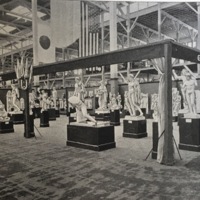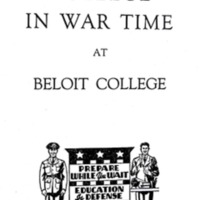Browse Exhibits (6 total)
I Need Space: Women's Extracurriculars at Beloit 1895-1920

Beloit College first admitted women in 1895. When they arrived on campus, they enrolled in the same classes as the men, but they organized their own clubs and other activities.
From 1895 through the early 1900s, women formed their own organizations. These let them express themselves and create their own spaces. This exhibit investigates the clubs and sports created in the early days of co-education.
Black Demands at Beloit College, 1969

The Black Demands of 1969 were a list of changes the black students at Beloit College wanted to see on campus. They wanted changes in the curriculum, faculty, admissions, living spaces, and the implementation of specific programs for minority students. The aim of the demands was to make black students feel comfortable and accepted on campus.
The Black Demands were created at the end of the Civil Rights Movement - both had goals for the inclusion of black people in a predominantly white society. While the demands were not implemented in exactly the way the students wanted, they did create a lasting effect on the history of Beloit College and inflicted gradual change on campus.
This exhibit intends to interrogate how the Black Demands has continually impacted Beloit College throughout the decades.
Beloit Students in the Civil War

The American Civil War launched the United States into turmoil when it began in 1861. By the end of the war in 1865, an estimated 620,000 soldiers were dead as a result of the war. Beloit College was not immune to the conflict, and many men associated with the college joined the Union Army.
Four hundred and seventy-nine soldiers from Beloit College served during the Civil War. Of these men, most were young and one hundred and eighty-six were privates. Fifty-three of the four hundred and seventy-nine did not come back alive.
On July 14th, 1869, Memorial Hall (now part of the Logan Museum of Anthropology) was dedicated to those Beloit soldiers who served in the Civil War. As part of this dedication, many relatives of Beloit soldiers sent in letters and memoirs to the College, recalling their lives and service.
Some of these young men had extensive letters written by family and friends memorializing them in text; the college still has these letters in its possession and some are transcribed for this project. Using these texts, as well as accounts from external sources, this exhibit seeks to map the movements of Beloit soldiers during their service in the Union Army. Five students have been selected for the purposes of this exhibit: Dudley Cowles, Edmund Dawes, Quincy Pollock, Whitney Tibbals, and Frank Edgar Woodruff.
Beloit College's Greek Cast Collection

The Greek Casts were acquired from the Greek government after being exhibited in the World Columbian Exposition that was held in Chicago in 1893. They were acquired with the help of Helen Brace Emerson and L. G. Fisher. Once acquired, the casts made their first home in the second Art Hall, in the old South College, and were dubbed “The Fisher Collection”. Of the original 112 plaster cast replicas, only 25 remain in the Wright Museum's catalogs. With most of the casts unaccounted for, either missing, sold, or destroyed, the collection is currently in much worse shape than when it was first debuted.
World War II at Beloit College

The students at Beloit College were affected by the war both overseas and back home. During the war, Beloit College changed their academic structure in order to incorporate a more military based education. This allowed students and service men to obtain their degrees at an accelerated pace so the service men could go off to fight in the war at higher rankings within the military.
While military trainings were focused around the service men of the 95th College Training Detachment, the social lives of all students were altered to focus around the military in a variety of ways such as calisthenics, bond sales, and dances for visiting soldiers.
This exhibit shows the changes that were made to both the academic and social lives of Beloit College students during the war.
Featured Exhibit
You have no featured exhibits.

